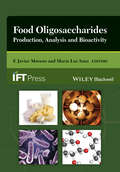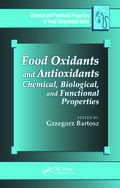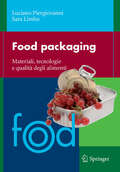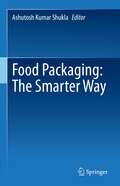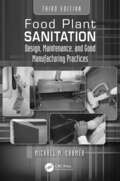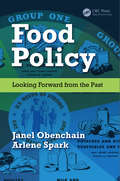- Table View
- List View
Food Oligosaccharides: Production, Analysis and Bioactivity (Institute of Food Technologists Series)
by F. Javier Moreno María Luz SanzA growing awareness of the relationship between diet and health has led to an increasing demand for food products that support health beyond simply providing basic nutrition. Digestive health is the largest segment of the burgeoning functional food market worldwide. Incorporation of bioactive oligosaccharides into foods can yield health benefits in the gastrointestinal tract and other parts of the body that are linked via the immune system. Because oligosaccharides can be added to a wide variety of foodstuffs, there is much interest within the food industry in incorporating these functional ingredients into healthy food products. Moreover, other areas such as pharmaceuticals, bioenergy and environmental science can exploit the physicochemical and physiological properties of bioactive oligosaccharides too. There is therefore a considerable demand for a concentrated source of information on the development and characterization of new oligosaccharides with novel and/or improved bioactivities. Food Oligosaccharides: Production, Analysis and Bioactivityis a comprehensive reference on the naturally occurring and synthesised oligosaccharides, which will enable food professionals to select and use these components in their products. It is divided into three sections: (i) Production and bioactivity of oligosaccharides, (ii) Analysis and (iii) Prebiotics in Food Formulation. The book addresses classical and advanced techniques to structurally characterize and quantitatively analyse food bioactive oligosaccharides. It also looks at practical issues faced by food industry professionals seeking to incorporate prebiotic oligosaccharides into food products, including the effects of processing on prebiotic bioavailability. This book is essential reading for food researchers and professionals, nutritionists and product developers working in the food industry, and students of Food Science with an interest in functional foods.
Food Oligosaccharides: Production, Analysis and Bioactivity (Institute of Food Technologists Series)
by F. Javier Moreno María Luz SanzA growing awareness of the relationship between diet and health has led to an increasing demand for food products that support health beyond simply providing basic nutrition. Digestive health is the largest segment of the burgeoning functional food market worldwide. Incorporation of bioactive oligosaccharides into foods can yield health benefits in the gastrointestinal tract and other parts of the body that are linked via the immune system. Because oligosaccharides can be added to a wide variety of foodstuffs, there is much interest within the food industry in incorporating these functional ingredients into healthy food products. Moreover, other areas such as pharmaceuticals, bioenergy and environmental science can exploit the physicochemical and physiological properties of bioactive oligosaccharides too. There is therefore a considerable demand for a concentrated source of information on the development and characterization of new oligosaccharides with novel and/or improved bioactivities. Food Oligosaccharides: Production, Analysis and Bioactivityis a comprehensive reference on the naturally occurring and synthesised oligosaccharides, which will enable food professionals to select and use these components in their products. It is divided into three sections: (i) Production and bioactivity of oligosaccharides, (ii) Analysis and (iii) Prebiotics in Food Formulation. The book addresses classical and advanced techniques to structurally characterize and quantitatively analyse food bioactive oligosaccharides. It also looks at practical issues faced by food industry professionals seeking to incorporate prebiotic oligosaccharides into food products, including the effects of processing on prebiotic bioavailability. This book is essential reading for food researchers and professionals, nutritionists and product developers working in the food industry, and students of Food Science with an interest in functional foods.
Food Oral Processing: Fundamentals of Eating and Sensory Perception
by Jianshe Chen Lina EngelenThis volume provides an overview of the latest research findings on the physics, physiology, and psychology of food oral consumption, as well as the experimental techniques available for food oral studies. Coverage includes the main physical and physiological functionalities of the mouth; the location and functionalities of various oral receptors; the main sequences of eating and drinking, and the concomitant food disintegration and destabilisation. Chapters also explain oral processing and its relation to flavour release and texture perception, and there is an introduction to the principles of food rheology as they relate to eating. Food Oral Processing is directed at food scientists and technologists in industry and academia, especially those involved in sensory science and new product development. It will also be of interest to oral physiologists, oral biologists and dentists. The book will be a useful reference for undergraduate and postgraduate students of these disciplines.
Food Oral Processing: Fundamentals of Eating and Sensory Perception
by Jianshe Chen Lina EngelenThis volume provides an overview of the latest research findings on the physics, physiology, and psychology of food oral consumption, as well as the experimental techniques available for food oral studies. Coverage includes the main physical and physiological functionalities of the mouth; the location and functionalities of various oral receptors; the main sequences of eating and drinking, and the concomitant food disintegration and destabilisation. Chapters also explain oral processing and its relation to flavour release and texture perception, and there is an introduction to the principles of food rheology as they relate to eating. Food Oral Processing is directed at food scientists and technologists in industry and academia, especially those involved in sensory science and new product development. It will also be of interest to oral physiologists, oral biologists and dentists. The book will be a useful reference for undergraduate and postgraduate students of these disciplines.
Food Oxidants and Antioxidants: Chemical, Biological, and Functional Properties
by Grzegorz BartoszFood antioxidants are of primary importance for the preservation of food quality during processing and storage. However, the status of food depends on a balance of antioxidants and prooxidants occurring in food. Food Oxidants and Antioxidants: Chemical, Biological, and Functional Properties provides a single-volume reference on the effects of natur
Food Packaging: Materials,Techniques and Environmental Issues (Lecture Notes in Management and Industrial Engineering)
by Anup K. Ghosh N. C. Saha Meenakshi Garg Susmita Dey SadhuThis comprehensive and authoritative book aims to encompass the best and current practices in the field of contemporary food packaging. It covers various aspects of packaging, including challenges and their solutions, innovations, and environmental concerns. Written by experts working in the field, the content is supported by technical/statistical data, practical examples, case studies, and real-life experiences of academicians and professionals working in the area of food packaging. The book covers challenges in food packaging, systems and materials for packaging, packaging design requirements of the food industry, technology machinery and system, printing and graphics, testing and regulatory aspects, advanced and smart packaging, distribution and logistics in a globalized environment, and sustainable and green packaging. This book will be useful for Packaging Technologists, food scientists, material scientists, policy makers, students, and researchers.
Food packaging: Materiali, tecnologie e soluzioni (Food)
by Luciano Piergiovanni Sara LimboIl volume è rivolto agli studenti universitari dei corsi di Laurea in Scienze e Tecnologie Alimentari, Scienze e Tecnologie Agrarie e Scienze e Tecnologie della Ristorazione che devono acquisire nei loro studi conoscenze, competenze e abilità relative all’ambito multidisciplinare del confezionamento di alimenti e bevande. Lo scopo dell’opera è però anche quello di rendere disponibile un testo di utilità più ampia e generale, indirizzato ai tecnici e agli operatori che nelle aziende di produzione di alimenti, o di imballaggi per alimenti, sono interessati ad un approfondimento e ad un aggiornamento scientifico-tecnologico nell’area. Frutto dell’esperienza degli Autori che insegnano questa materia da molti anni nella Facoltà di Agraria dell’Università degli Studi di Milano, l’opera offre la combinazione di esperienze didattiche e scientifiche in questo specialistico campo permettendo di affrontare il complesso ed articolato tema delle Tecnologie di Food Packaging in modo esauriente, aggiornato ed approfondito per garantire agli studenti ed ai docenti di Tecnologie Alimentari, così come a chiunque interessato alla materia, un efficace strumento di studio e di consultazione.
Food Packaging: Principles and Practice, Third Edition
by Gordon L. RobertsonFood Packaging: Principles and Practice, Third Edition presents a comprehensive and accessible discussion of food packaging principles and their applications. Integrating concepts from chemistry, microbiology, and engineering, it continues in the tradition of its bestselling predecessors and has been completely revised to include new, updated, and
Food Packaging: Principles and Practice, Third Edition
by Gordon L. RobertsonFood Packaging: Principles and Practice, Third Edition presents a comprehensive and accessible discussion of food packaging principles and their applications. Integrating concepts from chemistry, microbiology, and engineering, it continues in the tradition of its bestselling predecessors and has been completely revised to include new, updated, and
Food Packaging and Preservation
by M. MathlouthiThis book is an updating of Food Packaging and Preservation, Theory and Practice published in 1986 by Elsevier Applied Science. Since that date, many things have changed in the world. Hence the name given to the first IFTEC meeting held at the Hague (NL), November 15-18, 1992 Food Technology for a Changing World. Is the world changing for better or worse and what can food technology improve? The keynote lecture of the IFTEC meeting dealt with hunger and the challenge it represents to food science and technology. In the preface to the 1986 book it was suggested that food packaging could solve some of the problems of crop preservation in countries where starvation is prevalent. However, such thoughts did not solve any problems. The famine is still spreading in Africa. The unbalanced north-south situation evoked in the 1986 preface has not improved. The international market of foods and agricultural products is constantly changing and food packaging scientists can only explore new ways to help cope with this. Some of these ideas are approached in this book, particularly in chapters 9, 10 and 12.
Food Packaging Hygiene (SpringerBriefs in Molecular Science)
by Caterina Barone Luciana Bolzoni Giorgia Caruso Angela Montanari Salvatore Parisi Izabela SteinkaThis Brief is concerned with the connection between food packaging and the chemical composition of packaging materials. In terms of the food packaging hygiene, the influence of the containers on the contained foods is discussed. The book explores new and emerging risks related to food packaging materials in connection with the contained commodities. It also discusses the technology of production with relation to the chemical risk in a “Hazard Analysis and Critical Control Point” (HACCP) investigation.
Food Packaging Materials: Current Protocols (Methods and Protocols in Food Science)
by Caio OtoniThis volume details methods for reproducible procedures for food packaging. Chapters are divided into three parts covering chemicals and apparatuses, recommended procedures, reproducibility, and remarks and tips to troubleshoot pitfalls. Written in the format of the Methods and Protocols in Food Science series, chapters list necessary materials and methods for readily reproducible protocols. Authoritative and cutting-edge, Food Packaging Materials aims to be a comprehensive, high-quality manual for researchers in both academia and industry.
Food Packaging Materials (SpringerBriefs in Molecular Science)
by Luciano Piergiovanni Sara LimboThis Brief is concerned with the material chemistry of food packaging materials. It introduces the properties and peculiarities of typical packaging materials, such as plastics, cellulose components, ceramics and metals. Their overall performance as food packaging material is determined by the chemical and physical properties. The Brief describes how the final properties of a food packaging material can be influenced through chemical modifications in the structure and composition of the used components. The authors also cover potential chemical reactions of food packaging materials that may affect their performance. Potential hazards that may arise, such as influences on the product quality, or effects on their recycling or disposal, are discussed. Different influences, like metal corrosion, chemical resistance and degradability of the main packaging materials, or properties like hydrophobicity, surface energy and migration have to be taken into account. This Brief gives an introduction to all these different aspects of food packaging.
Food Packaging Materials: Testing & Quality Assurance
by Preeti Singh Ali Abas Wani Horst-Christian LangowskiThis book is arguably the first one focusing on packaging material testing and quality assurance. Food Packaging Materials: Testing & Quality Assurance provides information to help food scientists, polymer chemists, and packaging technologists find practical solutions to packaging defects and to develop innovative packaging materials for food products. Knowledge of packaging material testing procedures is extremely useful in the development of new packaging materials. Unique among books on packaging, this reference focuses on basic and practical approaches for testing packaging materials. A variety of packaging materials and technologies are being used, with glass, paper, metal, and plastics as the most important groups of materials. Material properties such as mechanical and other physical properties, permeability, sealing, and migration of substances upon food contact are determining factors for food quality, shelf life, and food safety. Therefore, food packaging materials have to be tested to ensure that they have correct properties in terms of permeability for gases, water vapor, and contaminants; of mechanical and other physical properties; and of the thickness of main components and coating layers. This book has been designed to shed light on food packaging material testing in view of packaging integrity, shelf life of products, and conformity with current regulations. This comprehensive book, written by a team of specialists in the specific areas of food packaging, package testing, and food contact regulations, deals with the problems in a series of well-defined chapters. It covers the relations between packaging properties and shelf life of products and describes testing methods for plastics, metal, glass, and paper, including the areas of vibration, permeation, and migration tests. It will be of benefit for students, scientists, and professionals in the area of food packaging.
Food Packaging Materials: Testing & Quality Assurance
by Preeti Singh Ali Abas Wani Horst-Christian LangowskiThis book is arguably the first one focusing on packaging material testing and quality assurance. Food Packaging Materials: Testing & Quality Assurance provides information to help food scientists, polymer chemists, and packaging technologists find practical solutions to packaging defects and to develop innovative packaging materials for food products. Knowledge of packaging material testing procedures is extremely useful in the development of new packaging materials. Unique among books on packaging, this reference focuses on basic and practical approaches for testing packaging materials. A variety of packaging materials and technologies are being used, with glass, paper, metal, and plastics as the most important groups of materials. Material properties such as mechanical and other physical properties, permeability, sealing, and migration of substances upon food contact are determining factors for food quality, shelf life, and food safety. Therefore, food packaging materials have to be tested to ensure that they have correct properties in terms of permeability for gases, water vapor, and contaminants; of mechanical and other physical properties; and of the thickness of main components and coating layers. This book has been designed to shed light on food packaging material testing in view of packaging integrity, shelf life of products, and conformity with current regulations. This comprehensive book, written by a team of specialists in the specific areas of food packaging, package testing, and food contact regulations, deals with the problems in a series of well-defined chapters. It covers the relations between packaging properties and shelf life of products and describes testing methods for plastics, metal, glass, and paper, including the areas of vibration, permeation, and migration tests. It will be of benefit for students, scientists, and professionals in the area of food packaging.
Food Packaging Science and Technology
by Dong Sun LeeWith a wealth of illustrations, examples, discussion questions, and case studies, the Food Packaging Science and Technology covers basic principles and technologies as well as advanced topics such as active, intelligent, and sustainable packaging with unparalleled depth and breadth of scope. Emphasizing the application of relevant scientific
Food Packaging: The Smarter Way
by Ashutosh Kumar ShuklaThis book reviews the science and technology of food packaging and covers the potential innovations in the food packaging sector. At the same time, it highlights the issues and prospects for linking the laboratory research to the market. In addition to typical packaging requirements such as food quality, shelf life, protection, communication, and marketing, the book emphasizes the need for novel packaging materials, including biodegradable packaging for a variety of food products. A wide range of food products has been kept in focus and includes animal-based food products such as dairy products and sea foods. The book presents the next level of packaging solutions i.e., smart packaging with the applications of potential tools such as intelligent and active packaging, and includes the latest research on emerging digital technologies for packaging development, assessment, and acceptability. It further highlights the strategies including blends, reinforcing agents, cold plasma, UV light applications, chemical, and enzymatic methods and explores the new opportunities leading to improvement in the packaging performance. Smart freshness indicator applications, including gas and time-temperature indicators for quality and safety of packaged products, have been covered in detail. The book also includes the functional characteristics of edible films and coatings, including their bioactive characteristics. Finally the book presents the rules and regulation related to packaging.
Food, People and Society: A European Perspective of Consumers' Food Choices
by Lynn J. Frewer Einar Risvik Hendrik SchiffersteinA unique insight into the decision-making and food consumption of the European consumer. The volume is essential reading for those involved in product development, market research and consumer science in food and agro industries and academic research. It brings together experts from different disciplines in order to address the fundamental issues related to predicting food choice, consumer behavior and societal trust in quality and safety regulatory systems. The importance of the social and psychological context and the cross-cultural differences and how they influence food choice are also covered in great detail.
Food Physics: Physical Properties - Measurement and Applications
by Ludger O. Figura Arthur A. TeixeiraThis is the first textbook in this field of increasing importance for the food and cosmetics industries. It is indispensable for future students of food technology and food chemistry as well as for engineers, technologists and technicians in the food industries. It describes the principles of food physics starting with the very basics – and focuses on the needs of practitioners without omitting important basic principles. It will be indispensable for future students of food technology and food chemistry as well as for engineers, technologists and technicians in the food industries. Food Physics deals with the physical properties of food, food ingredients and their measurement.
Food Physics: Physical Properties - Measurement and Applications
by Ludger Figura Arthur A. TeixeiraThis is the first textbook in this field of increasing importance for the food and cosmetics industries. It is indispensable for future students of food technology and food chemistry as well as for engineers, technologists and technicians in the food industries. It describes the principles of food physics starting with the very basics – and focuses on the needs of practitioners without omitting important basic principles. It will be indispensable for future students of food technology and food chemistry as well as for engineers, technologists and technicians in the food industries. Food Physics deals with the physical properties of food, food ingredients and their measurement.
Food Plant Sanitation: Design, Maintenance, and Good Manufacturing Practices
by Michael M. CramerFood safety and quality are primary concerns in the food manufacturing industry. Written by an author with more than 40 years’ experience in the food industry, Food Plant Sanitation: Design, Maintenance, and Good Manufacturing Practices, Third Edition provides completely updated practical advice on all aspects of food plant sanitation and sanitation-related food safety issues. It offers readers the tools to establish a food safety system to help control microbiological, physical, and chemical hazards. Understanding that sanitation is integral to food safety is the foundation for an effective food safety system. Features of this new edition include new photographs, tables, and up-to-date material that better reflect current guidance on food plant sanitation, including additional information on the implementation of FSMA. The chapters address testing for and control of microorganisms in food manufacturing, including recent challenges in the industry due to pathogens such as Listeria monocytogenes. They also offer discussions on biofilms, regulatory requirements from the European Union, allergens, sanitary facility design, and describe proven best practices for sanitation as well as current sanitary requirements and regulatory changes from the FDA and USDA. In addition, the author presents methods for verifying sanitation, and provides greater differentiation of verification versus validation. The final chapters identify good manufacturing practices for employees and present a comprehensive pest management plan, including control measures and chemical interventions. The book concludes with strategies for preventing chemical and physical food safety hazards. This reference provides a practical perspective for implementing food plant sanitation and safety processes. The author has included, wherever possible, examples of procedures, forms, and documents to help novice food safety and quality professionals develop effective food safety systems.
Food Plant Sanitation: Design, Maintenance, and Good Manufacturing Practices
by Michael M. CramerFood safety and quality are primary concerns in the food manufacturing industry. Written by an author with more than 40 years’ experience in the food industry, Food Plant Sanitation: Design, Maintenance, and Good Manufacturing Practices, Third Edition provides completely updated practical advice on all aspects of food plant sanitation and sanitation-related food safety issues. It offers readers the tools to establish a food safety system to help control microbiological, physical, and chemical hazards. Understanding that sanitation is integral to food safety is the foundation for an effective food safety system. Features of this new edition include new photographs, tables, and up-to-date material that better reflect current guidance on food plant sanitation, including additional information on the implementation of FSMA. The chapters address testing for and control of microorganisms in food manufacturing, including recent challenges in the industry due to pathogens such as Listeria monocytogenes. They also offer discussions on biofilms, regulatory requirements from the European Union, allergens, sanitary facility design, and describe proven best practices for sanitation as well as current sanitary requirements and regulatory changes from the FDA and USDA. In addition, the author presents methods for verifying sanitation, and provides greater differentiation of verification versus validation. The final chapters identify good manufacturing practices for employees and present a comprehensive pest management plan, including control measures and chemical interventions. The book concludes with strategies for preventing chemical and physical food safety hazards. This reference provides a practical perspective for implementing food plant sanitation and safety processes. The author has included, wherever possible, examples of procedures, forms, and documents to help novice food safety and quality professionals develop effective food safety systems.
Food Policy: Looking Forward from the Past
by Janel Obenchain Arlene SparkAccess to safe, adequate, and nutritionally balanced food is a cornerstone of public health. Food Policy: Looking Forward from the Past examines the influences of grassroots movements, the government, and industry on the US food systems. The authors explore the intersection of food and nutrition and how policy influences this overlap. They illumina
Food Poverty and Insecurity: International Food Inequalities (Food Policy)
by Martin Caraher John CoveneyThis volume is concerned with food poverty and action on food (in)security. The context is a global one; as the developed world faces a problem with overconsumption and chronic diseases, the developing world is addressing the double burden of hunger and over consumption. Even in the developed world, nation states are facing the rise of modern malnutrition which is over consumption, but also the re-emergence of hunger as there are growing levels of poverty and inequality due to the financial crises. Food insecurity is in many people’s minds associated with hunger, and while this is true the modern food system has introduced new complexities to food insecurity with the growth of micro-nutrient inequalities. Hunger and obesity are not being faced by two different groups but often the same group or cohort. These are features of modern malnutrition that are often not recognized. A critical examination of food poverty and food security is undertaken, with a view to clarifying taken-for-granted assumptions in present discourses. The book addresses food charity and the rise of solutions such as foodbanks as appropriate social responses. The final chapters explore the solutions from real life situations. The concluding chapter from the editors draws together the issues and locates solutions within a food policy framework of the total food system. The various definitions of food insecurity will are examined. Hunger and its modern manifestations (hunger and obesity) is another focus, with particular explorations of developed and developing countries experiences. Some of the chapters cover how food poverty/insecurity is being addressed and provide examples of work in progress.
Food Powders: Physical Properties, Processing, and Functionality (Food Engineering Series)
by Enrique Ortega-Rivas Pablo Juliano Hong YanThis useful reference is the first book to address key aspects of food powder technology. It assembles organized and updated information on the physical properties, production, and functionality of food powder, previously unavailable in book form.
